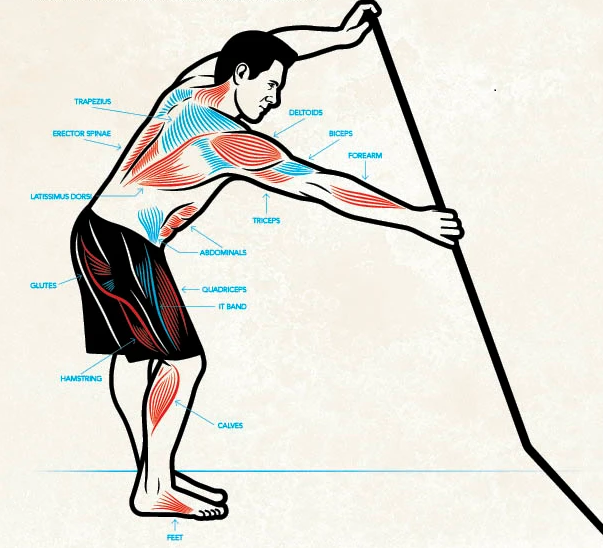9 Little-Known Health Benefits Of Stand Up Paddleboarding Proven By Science
*We may earn a commission for purchases made using our links. Please see our disclosure to learn more.
Paddleboarding changed my life! That’s no secret… The number of paddleboarding benefits that you can experience from this watersport is extremely eye-opening. It helped me eliminate anxiety, improve my fitness and has made me happier than I could have imagined before.
Not only is it a fun and exciting way to be out in nature, but it’s also a fantastic way to improve your overall well-being and I strongly believe that if you give it a chance then you’ll experience many of these paddleboarding benefits yourself.
In this article, I will delve into the incredible health benefits of SUP, supported by scientific research.
| Looking for our best paddle board product recommendations? Check the Paddleboard Insiders Buyer Guides |
Table Of Contents
- Introduction to Stand Up Paddleboarding (SUP)
- Physical Fitness Benefits of SUP
- Cardiovascular Health Benefits of SUP
- Mental Health Benefits of SUP
- Weight Management Benefits of SUP
- Joint and Muscle Health Benefits of SUP
- Rehabilitation and Injury Prevention Benefits of SUP
- Social and Community Benefits of SUP
- Immune System Benefits of SUP
- Improved Sleep Quality Benefits of SUP
- Safety Tips and Precautions for SUP
- Conclusion: A World Of Paddleboarding Benefits
- FAQs
- Is stand up paddleboarding suitable for all ages and fitness levels?
- Can I do stand up paddleboarding in any body of water?
- How long does it take to learn stand up paddleboarding?
- Do I need any special equipment to start stand up paddleboarding?
- What are some additional health benefits of being in nature while paddleboarding?
Introduction to Stand Up Paddleboarding (SUP)
Before we explore the health benefits, let’s briefly understand what stand up paddleboarding is all about. SUP involves standing on a paddleboard and using a paddle to navigate through water. It has gained tremendous popularity in recent years due to its versatility and accessibility. Originally rooted in Hawaiian heritage, SUP has evolved into a global phenomenon that attracts people of all ages and fitness levels.
Physical Fitness Benefits of SUP
One of the primary advantages of stand up paddleboarding is the physical fitness it promotes. Unlike traditional forms of exercise, SUP engages your entire body, providing a full-body workout.
By maintaining balance on the board and propelling yourself forward with each stroke, you activate and strengthen your core muscles, including your abdominal, back, and pelvic muscles. Additionally, the constant paddling action works your arms, shoulders, and upper body, resulting in improved muscle strength and endurance.
You can see below how many different muscle groups are engaged while paddleboarding. You can see that this makes it an amazing way to burn calories and lose weight.

Cardiovascular Health Benefits of SUP
Engaging in regular cardiovascular exercise is crucial for maintaining a healthy heart and reducing the risk of cardiovascular diseases. SUP offers an excellent way to enhance your cardiovascular endurance. Paddling on the water increases your heart rate and promotes blood circulation, resulting in improved cardiovascular health.
A recent study that was conducted by Polar discovered that all paddleboarders (besides novices that were instructed to paddle at a leisurely pace) were reaching 64% of their maximum heart rate and conducting ‘moderate-intensity exercise’.
Your breathing and heart rate increases because your body requires more oxygen. This gets your lungs working and strengthens them along with reducing inflammation and even helping with asthma symptoms.
This is an incredible benefit that I personally experienced the more that I made exercise a priority in my life. And paddleboarding is a really fun and easy way to do that.

What makes SUP even more appealing is its low-impact nature, which minimizes stress on your joints while still providing an effective workout. This means that you are much less likely to get wear and tear injuries from this sport than you would from something like running or weights (because there’s much less impact on your joints and muscles).
Mental Health Benefits of SUP
In addition to the physical benefits, stand up paddleboarding also has a positive impact on mental well-being. The peaceful and serene environment of being on the water promotes relaxation and stress reduction.
The rhythmic paddling motion combined with the soothing sound of water creates a calming effect, allowing you to escape from the daily stresses of life. Furthermore, spending time in nature has been scientifically proven to boost mood, alleviate symptoms of anxiety and depression, and improve overall mental well-being.
It has even been shown to minize the risk of developing alzheimers! How amazing is that for a benefit?
Weight Management Benefits of SUP
If you’re looking to shed some pounds or maintain a healthy weight, SUP can be an excellent addition to your fitness routine. Stand up paddleboarding is a calorie-burning activity that engages multiple muscle groups simultaneously. Paddling vigorously can help you burn a significant number of calories, contributing to weight loss.
Moreover, the increased muscle mass and boosted metabolism resulting from regular SUP sessions can lead to improved body composition and long-term weight management – this makes it easier to manage your weight over the long term.
Joint and Muscle Health Benefits of SUP
Unlike high-impact activities like running or intense weightlifting, stand up paddleboarding is gentle on your joints while still providing an effective workout. The buoyancy of the water reduces the impact on your joints, making it a suitable exercise for individuals with joint-related issues or those recovering from injuries. Paddleboarding has been proven by science to reduce the risk of you developing arthritis.

Additionally, the balancing and stabilizing required during SUP improve joint flexibility and mobility, reducing the risk of future injuries. It also helps alleviate muscle imbalances and correct postural issues.
Rehabilitation and Injury Prevention Benefits of SUP
Another remarkable aspect of SUP is its rehabilitation and injury prevention benefits. For individuals recovering from certain injuries or surgeries, traditional exercise options may be limited. Stand up paddleboarding offers a low-impact alternative that helps with rehabilitation while avoiding excessive strain on healing tissues.
The increase in bloodflow all around your body is kinda like an ice bath for healing (without the cold).

It strengthens the muscles surrounding the injured area, promotes healing, reduces inflammation and enhances overall recovery. Furthermore, engaging in regular SUP sessions can help prevent future injuries by improving core strength, balance, and joint stability.
Social and Community Benefits of SUP
Beyond the individual health benefits, stand up paddleboarding also provides an opportunity for social interaction and community building. Joining a SUP club or participating in events and races allows you to meet like-minded individuals who share your passion for this sport. The sense of camaraderie and support within the SUP community can be both motivating and inspiring.

Whether it’s sharing paddleboarding tips, exploring new locations together, or simply enjoying the company of fellow enthusiasts, the social aspect of SUP adds an extra dimension to the overall experience.
And it’s really fun to do with your friends! The fact that you’re out on the water together makes it an easy situation to connect and bond with your friends in an unplugged environment without phones and the internet.
Immune System Benefits of SUP
Spending time outdoors, especially on the water, exposes you to fresh air and sunlight, which are essential for maintaining a healthy immune system. Stand up paddleboarding provides an opportunity to enjoy nature while soaking up vitamin D from the sun, a vital nutrient for bone health and immune system function.
Regular outdoor activity and increased vitamin D levels have been associated with enhanced immune system response and overall well-being. Because you experience so much vitamin D exposure from paddleboarding, it can even help alleviate seasonal affective disorder (SAD)
Improved Sleep Quality Benefits of SUP
Good quality sleep is crucial for overall health and well-being. Stand up paddleboarding can contribute to better sleep in several ways. First, the physical exertion and fatigue from paddling provide a natural way to induce sleepiness and promote a more restful night’s sleep.
Second, the calming effects of being on the water and connecting with nature can help reduce stress and anxiety, leading to improved sleep. Lastly, engaging in SUP regularly establishes a routine, which can regulate your body’s internal clock and improve sleep-wake cycles.
Sounds like a pretty incredible benefit to me 🙂

Safety Tips and Precautions for SUP
While stand up paddleboarding is generally safe and enjoyable, it’s essential to follow certain safety guidelines. Here are some tips to ensure a safe SUP experience:
- Always wear a personal flotation device (PFD) to ensure your safety in case of an accident or sudden change in weather conditions.
Check out the most important accessories for paddleboarding here:
The 23 Best Paddleboard Accessories That You Need In 2024 - Check the weather forecast before heading out to avoid unfavorable conditions such as strong winds or storms.
- Learn and practice proper paddling techniques to improve efficiency and prevent overexertion or injury. Make sure that you have a good paddle that helps with your posture to prevent posture related strain.
- Be aware of your surroundings, including other watercraft and potential hazards in the water.
- Stay hydrated and apply sunscreen to protect yourself from the sun’s rays, even on cloudy days.
Conclusion: A World Of Paddleboarding Benefits
Stand up paddleboarding offers an incredible array of health benefits that extend beyond mere physical fitness. From cardiovascular health and weight management to mental well-being and joint health, SUP is a versatile activity that enhances overall well-being. By incorporating SUP into your lifestyle, you can enjoy the wonders of being on the water while reaping the numerous rewards for your body and mind.
| Looking for insider guides to some amazing paddle boarding locations? Check the Paddleboard Insiders Location Guides |
FAQs
Is stand up paddleboarding suitable for all ages and fitness levels?
Absolutely! Stand up paddleboarding can be enjoyed by people of all ages and fitness levels. It can be adapted to different skill levels and modified to suit individual capabilities.
Can I do stand up paddleboarding in any body of water?
Yes, stand up paddleboarding can be done in various bodies of water, including lakes, rivers, and oceans. However, it’s essential to consider the specific conditions and choose a suitable location based on your skill level.
How long does it take to learn stand up paddleboarding?
The learning curve for stand up paddleboarding varies from person to person. With proper instruction and practice, most individuals can gain basic proficiency within a few hours or a couple of sessions.
Do I need any special equipment to start stand up paddleboarding?
To get started with stand up paddleboarding, you’ll need a paddleboard and a paddle. It’s also recommended to wear a personal flotation device (PFD) and use a leash to keep you connected to the board in case of a fall.
What are some additional health benefits of being in nature while paddleboarding?
Being in nature has been linked to various health benefits, such as reduced stress levels, improved mood, increased cognitive function, and enhanced overall well-being. Combining stand up paddleboarding with the tranquility of natural surroundings amplifies these benefits, promoting a deeper sense of connection and rejuvenation.





